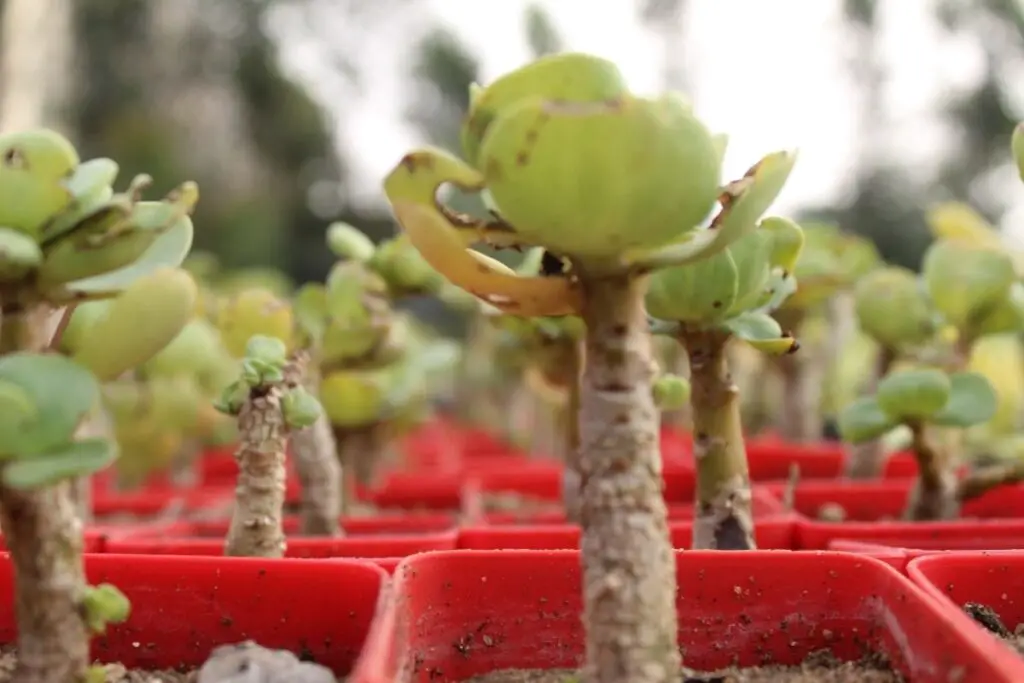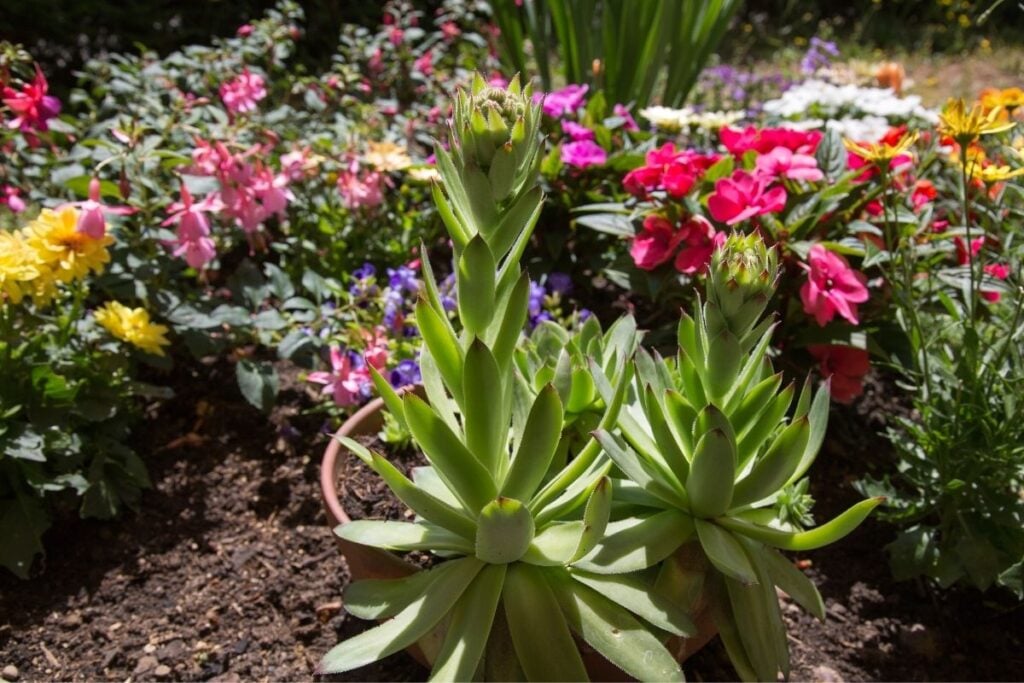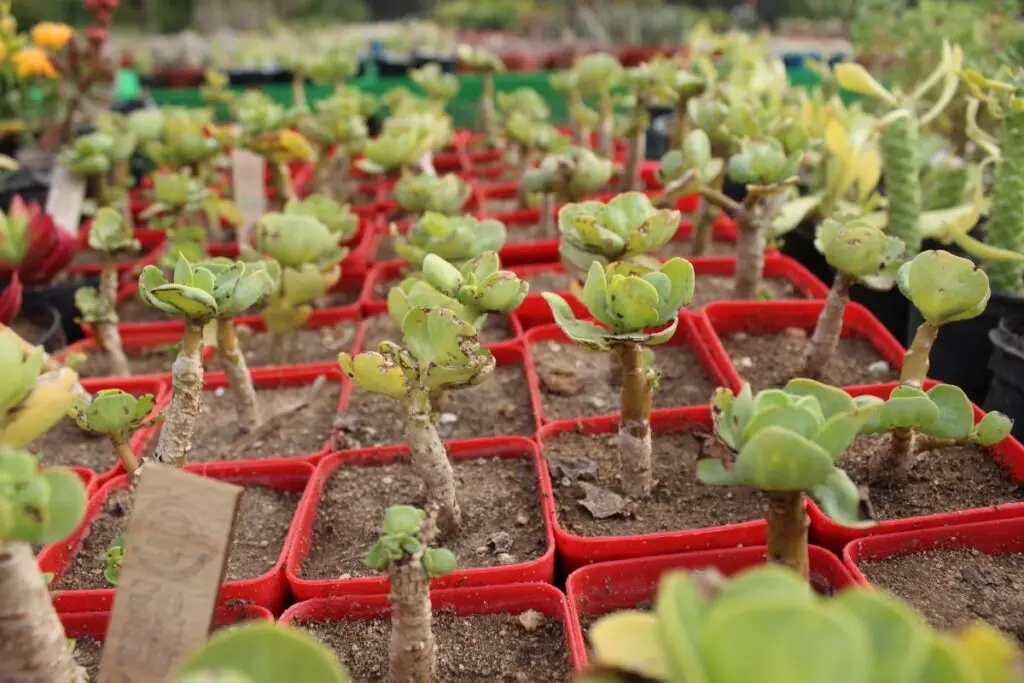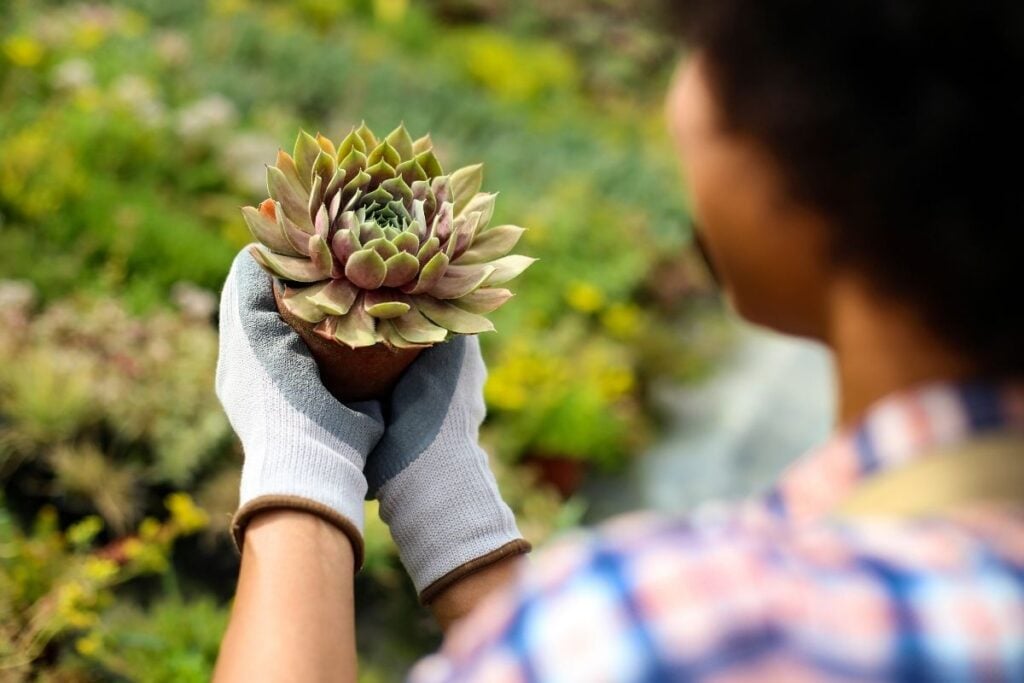Hens and Chicks are succulents grown both indoors and outdoors. They are famous for their ability to tolerate low temperatures and reproduce small plants. But seeing Hens and chicks growing leggy can be very frustrating. So, in this article, we shall learn how do you fix leggy hens and chicks?
The primary cause of leggy Hens and Chicks is the lack of sunlight. To fix this, you need to trim off the leggy part and move the plant to a sunny spot where it can get enough sunlight. Sometimes the plant sends a flowering stalk from the center to make the plant look leggy, but it’s natural.
This article will provide you with proper knowledge of the reasons behind leggy Hens and Chicks and how to fix them. Along with that, I will also share some care tips to keep the Hens and Chicks healthy.

Why is my Hen and chicks growing tall?
There are two reasons as to why Hens and Chicks grow leggy:
- Lack of light source
- Flowering
The first one is a problem and should be solved quickly before anything wrong happens to the plant. Flowering is a part of the plant’s lifecycle. Read further to know more about it.
Lack of adequate sunlight
Hens and Chicks are those succulents that have a rosette shape. These kinds of succulents grow their length and width of the rosette in proportion.
Hens and Chicks require a lot of sunlight for at least 8-10 hours. Some require 4-6 hours of sunlight. However, that depends on the variety.
When Hens and Chicks don’t receive enough light, they grow leggy quickly. This process is called etiolation.
In botanical science, etiolation is where seeds or plants are grown under low lights. The method is described as a deficiency of chlorophyll and low chloroplast formation by enlarging the space between the nodes and lack of xylem.
When the Hens and Chicks get less light, they bend towards the sunlight and continue growing leggy. The space between the leaves starts increasing due to this stretchiness. The leaves turn small and pale due to low chlorophyll.
When the plant grows leggy, it means they are trying to reach out for some light source. They grow tall and leggy at a relatively faster rate.
This growth is unhealthy for the plant. If not fixed quickly, the plant will die within a few months.
Also read: How Much Sun Do Hen And Chicks Need? (Light Requirement)
How to fix lighting for Hens and chicks?
If your Hens and chicks plant grows in low light conditions, you need to transplant them to a sunny spot. Different varieties require different light conditions. So plant them according to that.
Exposing the smaller varieties to direct sunlight throughout the day can cause sunburn.
Transplant your Hens and Chicks to a planting site that receives sufficient sunlight. There shouldn’t be any tall trees or buildings to block the sunlight from reaching the site. Otherwise, they will start growing leggy again.
For indoors, keep them near a sunny window, like southern, western, or eastern directions. You can also use grow lights.
Looking for gardening supplies? We have tested 100's of products before recommending them to you guys. Check out our best pick below:
| Image | Gardening Supplies | Best Price? |
|---|---|---|
 Top
Top Top
Top | Raised Garden Bed Kit | Check On Amazon |
 | XLUX Soil Moisture Meter, Plant Water Monitor, Soil Hygrometer Sensor for Gardening, Farming, Indoor and Outdoor Plants, No Batteries Required | No Results |
 Top
Top Top
Top | 82 Pcs Garden Tools Set and Extra Succulent Tools Set | Check On Amazon |
 | Joeys Garden Expandable Garden Hose with 8 Function Hose Nozzle, Lightweight Anti-Kink Flexible Garden Hoses, Extra Strength Fabric with Double Latex Core, (50 FT, Black) | No Results |
 Top
Top Top
Top | Dual Chamber Compost Tumbler | Check On Amazon |
 Top
Top Top
Top | Sunnyglade Plant Stakes | Check On Amazon |
 Top
Top Top
Top | Organic Cold Pressed Neem Seed Oil | Check On Amazon |
 Top
Top Top
Top | Mighty Mint Gallon :-Insect and Pest Control Peppermint Oil | Check On Amazon |
 Top
Top Top
Top | Scotts DiseaseEx Lawn Fungicide | Check On Amazon |
 Top
Top Top
Top | Jacks Classic 20-20-20 All Purpose Fertilizer | Check On Amazon |
 Top
Top Top
Top | 30,000 Seeds Pollinator Attracting Wildflower Mixture | Check On Amazon |
 Top
Top Top
Top | Survival Vegetable Seeds Garden Kit-Over 16,000 Seeds | Check On Amazon |
Flowering causes leggy Hens and Chicks

Flowering is a natural process of the Hens and Chicks plant, and the legginess caused due to this is not unhealthy.
After growing and reproducing for 3-4 years or more, they will die. But before they die, they will flower.
When the plant begins to flower, a stalk will grow from the center of a mature plant. It is a flower stalk, called a rooster. The flower stalk will continue to grow tall, about 1 inch to 1 ft.
This method is known as a monocarpic process. When this happens, it indicates that now it will grow a long stalk to flower, produce seeds, and die.
Some people confuse the legginess of flowering with the legginess due to light issues. When you see that the stem is weak and floppy, it is probably due to the light problem.
But when the stalk is round, firm, and bushy enough, it is a rooster growing to bloom for sure. The flower stalk will also have flower bud clusters facing up.
When the plant suddenly grows leggy, but the stalk is healthy, you don’t have to worry about it. Even if it dies, don’t get disheartened because they must have produced many baby chicks within these years.
Also read: Do Hens And Chicks Flower? (When, How & More)
Should I cut off the long stem or let it remain?
If you think that cutting the flower stalk off the plant will increase their lifespan, you are wrong. Someday, they will flower to die.
Eventually, they will die despite cutting off the flower stalk. Pruning off the stalk will not help.
However, if you want, you can cut off the stalk. It will give you one last chance to receive more baby plants. After that, they will die.
And if you let the stalk stay, you can enjoy beautiful star-like, pink flowers. When the flower dies, you will get lots of seeds. If you want to experience seed germination, you can do that.
How to fix leggy Hens and Chicks?

You should fix the problem of leggy Hens and Chicks within time. Or else, the plant will keep growing long due to the hindrances and become unhealthy.
Before you solve the problem, you need to do something with the extended part of the plant constantly growing upwards. Then, you can solve the problems. Let’s see what to do.
Once the Hens and Chicks start growing leggy, there is no coming back of the leggy parts. But, don’t worry. You can bring it back to its shape by pruning off the extended part from the plant.
Additionally, you can even profit from this condition.
- Cut off the leggy part from the plant using a sharp, disinfected knife or pruner.
- You should cut up to 2-4 centimeters of the stem.
- From the base, make sure that it has some leaves. It will ensure a good grasp of sunlight and breathing.
- Plant the cut stem at the same bed if space is left.
- Make sure that both the removed stem and the plant receive adequate sunlight.
- After 2-3 weeks, they will grow and even develop roots.
Though succulents can grow quickly from solely stems, having some leaves will increase their growth.
Let the stems dry out for a few days before planting. It will allow the wounded area (cut portion) to recover. It guarantees the prevention of infection in the injured area.
What to do next?
After you have completed trimming the extended part from the leggy plant, it will again begin to grow at its standard size and shape. But, you need to fix the light issues if you don’t want them to be leggy again.
Without fixing the problem, you won’t achieve your goal. If you still let the plant stay in the same place after pruning, it will grow tall for reaching a light source again.
Now, let’s understand how to fix the light issues for the Hens and chicks. It will ensure the plant never suffers such inconvenience and grow leggy.
Tips for healthy Hens and Chicks

Below I have shared some tips in brief that will keep the Hens and Chicks healthy if appropriately followed. Additionally, it will also stop the plant from becoming leggy. It won’t stop them from flowering, though.
Let’s see what the tips are:
- Plant your Hens and chicks at a site that receives at least 6 to 8 hours of daily sunlight. Receiving a good amount of sunlight can stop the Hens and Chicks from getting leggy.
- Hens and Chicks are drought-tolerant. That doesn’t mean they don’t need watering at all. You should water them whenever the top 1-2 inches of the soil gets dry.
- Water your Hens and Chicks once a week during their growing season. In the summer, you can increase the frequency if too hot and dry. It reduces the risk of sunburn. Decrease watering in the cold months.
- If you are unsure about proper feeding, don’t fertilize them. Not fertilizing won’t stop the growth. Instead, it prevents you from over-fertilizing, which will further keep the plant from growing leggy.
- If you want to fertilize, do it only once a year in the spring and summer only.
- Don’t worry about soil fertility. You must have got a clue from the previous point that Hens and chicks don’t require much nutrition.
- The matter of concern is drainage. The soil must retain moisture but must not hold excess moisture for long. Potting soil mixed with equal parts of sand or gravels, rocky soil, rock slabs with a small quantity of soil is some substrates suitable for the plant and their drainage.
- An average temperature for them ranging from 65-75 degrees is ideal for excellent growth. They will tolerate temperatures around -40°F, but will not endure extremely high temperatures.
Also read:
- What Kind Of Soil Do You Use For Hens And Chicks? (+Best Soil Mix)
- Hens And Chicks Temperature Tolerance: (How Cold, How Hot?)
- Can You Leave Hens And Chicks Outside In Winter?
Final thoughts on leggy Hens and Chicks
Now that you are familiar with the reasons behind leggy Hens and Chicks, you must avoid exposing them to such situations. However, there is nothing to do with the leggy growth due to flowering. It is their natural lifecycle.
Give them enough light, depending on their variety. It is better not to fertilize until you notice growth. Trimming the long flower stalk depends on you because, ultimately, the plant will die.
If you cut, you will get another round of baby plants. If you don’t remove the stalk, you can witness flower growth and collect the seeds.
In leggy growth due to low light, don’t hesitate to trim off the leggy part. Your plant will be back in its shape. You can even plant the cut portion to get another plant.
FAQs
How can I keep my Hens and Chicks from getting leggy?
To prevent Hens and Chicks from getting leggy:
- Let them have an adequate amount of light.
- Select a site that receives enough sunlight for planting.
- After planting them, keep them under shade for 2 weeks until the root grows.
Once they develop roots, remove the shade and let them have enough sunlight according to the variety. Water them additionally to save them from sunburns.
Do Hens and Chicks have a death after bloom?
Of course, they bloom before they die. It is one reason behind the leggy growth. After several years of growing and reproducing, they will flower, produce seeds and die. There is no fixation because it is natural.
Reference: Wikipedia, Iowa State University of Science and Technology, The University of Arkansas Division of Agriculture, NSDU, The Ohio State University, Missouri Botanical Garden.
